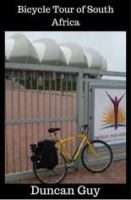
Photograph: The start of the stage to Addo
It was time to head for the Addo Elephant National Park.
Getting out of “Die Baai” (The Bay), as PE locals call their city, involved trying to find roads parallel to the N2 freeway in the direction of Grahamstown.
Mellow Yellow was, of course, not allowed on the freeway.
Early in the morning there was little traffic when I wandered on a road that was sheltered by the freeway. I passed a woman cooking in a shelter from which later on she would no doubt be selling hot food to earn her living.
That was when the road went happily parallel with the freeway. But soon it veered off elsewhere.
I found myself in an industrial area called North End. It seemed logical that there should a place in PE with such a name!
However, I felt hopelessly lost when it came to trying to work out how to get towards Addo. Then, I took a glance to the left and there I saw the Nelson Mandela Stadium, one of those built for the World Cup. It was the starting point of the second stage of the Tour of South Africa that would see cyclists heading for the game reserve at Addo, home to Africa’s Big Five.
On the road leading up to the stadium a shop boasted having Fifa credentials but it wasn’t yet open for business. It was too early in the day. However, a little further on a shop operating out of a garage had already opened up. I asked a young man behind the counter for directions towards Addo. He stared at me blankly, not able to understand a word I was saying.
I guessed he was a Bangladeshi immigrant, like the owners of a shop I’d been to back in Humewood some days before with whom I also battled to communicate. However, we broke the ice when I mentioned the name of their countryman, Muhammad Yunus, who had been a Nobel prize winner after starting the Grameen Bank, which lends poor people small amounts of money to start and grow little businesses.
COMMENT: How do you think the stadiums built for the 2010 Fifa World Cup can best be put to use now that the event is over?
****
Apart from a lone security guard in a fluorescent jacket there wasn’t a soul in sight around the stadium.
Eventually a man taking his early morning walk emerged and offered some complex instructions for how to get out of PE. I knew I would have to ask someone again around a few more corners.
Needless to say I once again became lost after not too long, but a woman sitting on a low wall beside a garage with a deeply-burned face and what I imagined were her worldly possessions in bags beside her, pointed me in the right direction.
She spoke well and I imagined that she had once lived a far better life. I gave her money for a morning cup of coffee.
A kilometre or so later I reached a point where the Grahamstown freeway, ahead of me, seemed the only way out of PE. I believed that going on to it was something I should rather not do; cars travel so must faster than bicycles that the drivers often don’t even see them. Besides they don’t even expect them to be on the freeways in the first place.
Then I saw a fellow cyclist, without a helmet, pedalling up on to an off-ramp in the opposite direction to oncoming traffic. His bad example led the way.
Halfway to being law abiding compared with him, I ventured up an onramp, in the same direction as the traffic and wearing a helmet.
By this time, the early morning quietness of PE’s roads was history. Morning rush hour was in full swing. The traffic was heavy, and fast. I chose to not even pedal but to rather push my bike as close to the curb as possible.
Eager to get off the freeway I took the first off-ramp, which the signs said would lead to “Settlaarsweg” (Settler’s Road). But lo and behold, it led on to another freeway. So I had to get back on to the freeway towards Grahamstown.
Spotting a gap between the passing trucks and cars, I darted over the road and across a large piece of lawn, back on to the Grahamstown freeway and felt rewarded for my efforts with a splendid view of inner city PE under heavy grey cloud from the north, as opposed to the view from the south with which I had become very familiar while exploring South End.
I thought back to the last issue of my newspaper, Learn the News, which I send out to schools, before the recent closure of the year. The lead story, set in Denmark, was for the need to create cycling freeways to bring an end to cycling traffic jams. What a different world Copenhagen must be to PE!
The road straightened out and went parallel to the coastline where massive concrete structures known as “dolosse” provided a barrier between the sea and the road. Their purpose is to prevent erosion by the sea.
Dolosse, which are shaped like hammers with heads at both ends of a short handle, and facing in opposite directions are in fact a South African invention. An Eastern Cape invention; not from Port Elizabeth but from East London.
COMMENT: Do you think South Africa cold ever be a country of cyclists, like Denmark?


